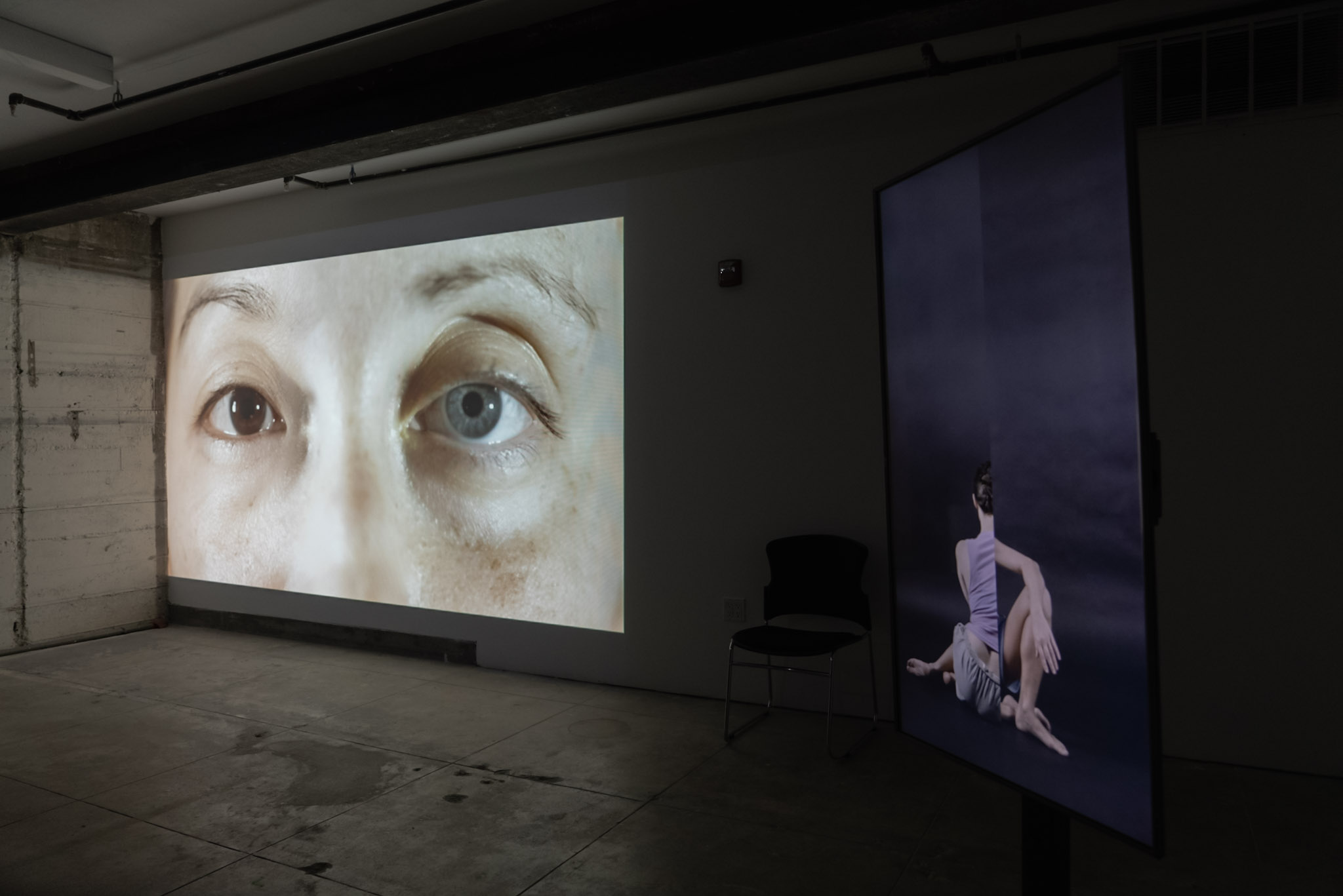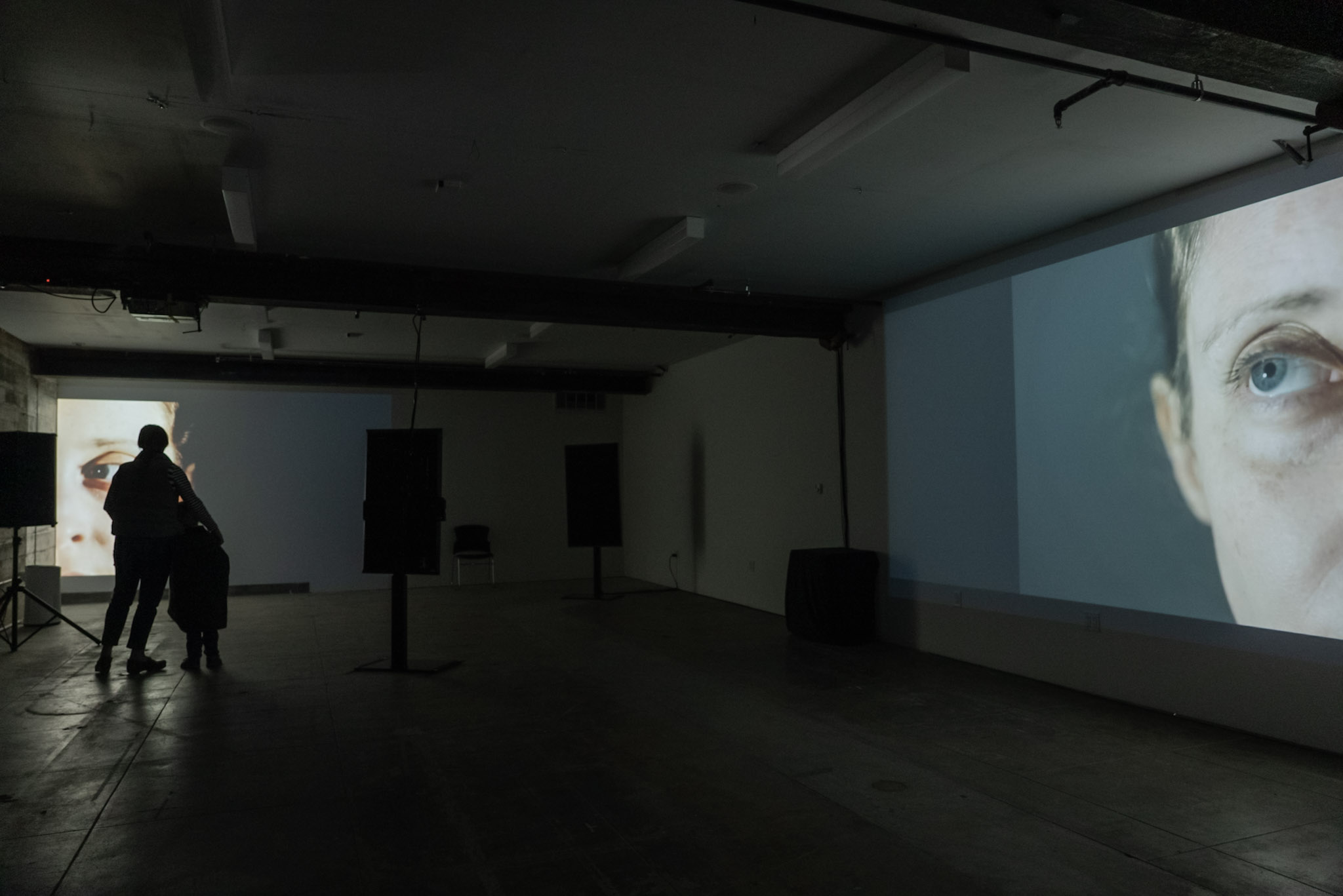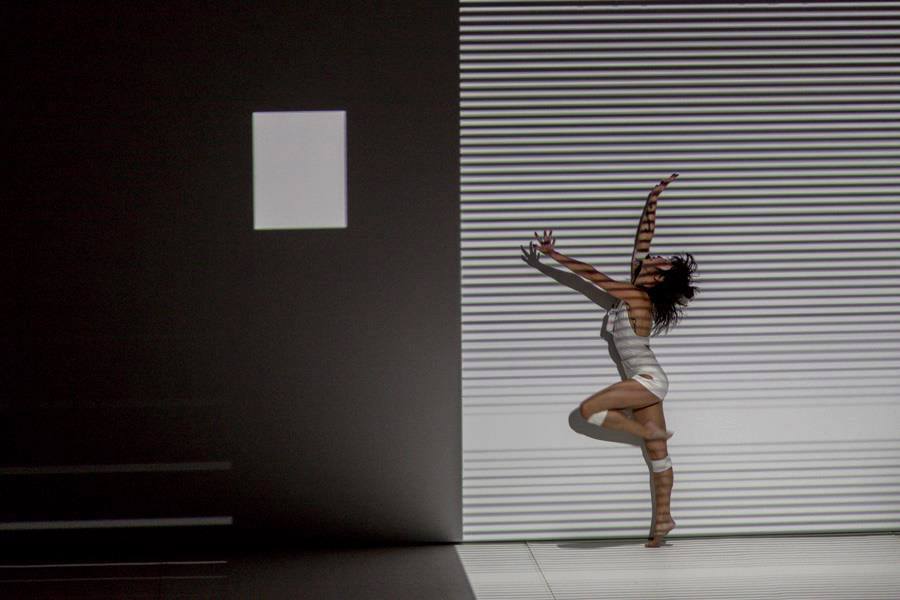Human/ID
research, residency, multi-channel video installation2022
Human/ID by StratoFyzika is an immersive media installation that considers the essence of identity and the body as our lives are mediated by screens. Created by Berlin-based interdisciplinary performance collective StratoFyzika, in collaboration with local artists Daria Kaufman and Ian Heisters, Human/ID is inspired by the personal, political, and social implications of synthetic media, specifically Deepfake, which uses AI to manipulate media and create alternate “truths.”
Human/ID dives into the uncanny valleys that form at the edges of new human mapping technologies, where human beings are rendered and translated through code. What is lost or gained in these liminal, digital spaces? What strange new perspectives do they offer of self, body, and other?
Daria Kaufman / Performer, Choreographer
Hen/i / Performer, Choreography
Ian Heisters / Creative Coding, ML, Video
Alessandra Leone ITA / Video
Dr. Gautam Agarwal - mentor / Data Analysis Visualization, Neuroscience
Danishta Rivero / Sound Design
Photos: Ian Heister




Kummerang Gloomerang BewegungLichterKlang
performance2018
This piece is one of thirteen new productions commissioned by the Haus für Poesie with the aim to explore boundaries and methodologies in the creation of performance work based on poetry. The tenth and eleventh performance event featured Scale of Grey and Kummerang Gloomerang BewegungLichterKlang in collaboration with Heroines of Sound editions on 28-29th May 2018.
Dagmara Kraus POL / Poesie
Hen USA / Tanz
Lenka Kocisova CZE / Musik)
Alessandra Leone ITA / Lighting, Visuals
Pics by Dario-Jacopo Laganà www.norte.it

↑ Pic by Dario-Jacopo Laganà www.norte.it
Our approach :
We attempt to trace how the poem can extend itself as a presence represented in the body, in space, through light and sound. While read aloud (by various people with different language backgrounds and accents) and concentrating on psycholinguistics, intonation and the melody of language, the sound translates another layer of interpretation by converting the recordings through pitch, rhythm, dynamics. Listening and looking at the sonic element of the poem and its graphical shape, with attempt to capture where attention lives in pointed directions of the mind. From here, the movement is directed by its manifestation into a map, transposed onto the physical space. The movement itself an interpretation of mood and physical expression of tone, meaning and the abstract dialogue between words and the corporeal. The lighting represents fluidity, form, rhythm and the repetition of the poetry. It dances with or against the body, adding another layer of interpretation: casting images and meaning through changes in intensity and angles. It creates directional pathways which cross or follow physical movement, counterpointed by quadraphonic spatial distribution of the sound. The score created for the lighting system is based on text mining and analysis work done on the poem keeping its architecture of empty spaces intact.



↑ Pics by Dieter Hartwig






↑Pics by Dario-Jacopo Laganà www.norte.it
Phi
performance2016 — 2017
Created by Lisbon/Berlin-based interdisciplinary performance collective StratoFyzika, Phi is an interactive, audiovisual dance performance based on looping patterns and their incremental alteration of perception. Centered around a highly physical and intricate duet, Phi melds movement, orbital light and sonic atmospheres into an immersive, striking performance that challenges the viewer's notion of body, space, and sound.
Daria Kaufman and Hen Ni Hen / Choreography and movement Alessandra AiKia Werkstatt / Light design
Akkamiau Kočičí / Quadraphonic sound

Using motion sensors and Isadora software, Alessandra Leone (Lighting Designer) and Thomas Van Ta (Creative Coder) have programmed two light projectors in correspondence with the dancers' movements, highlighting different angles and trajectories that distort and deconstruct the body. In one section, as the dancers travel down a narrow, diagonal beam of light and continually flip from their stomachs to their backs, the light flips with them – with each rotation, two opposing beamers switch on and off, causing the dancers' shadows and illuminated areas to continually shift. The effect is kinetic and paradoxical, as if simultaneously experiencing two different perspectives of the same moment.
Two dancers - Hen Lovely Bird and Daria Kaufman – created and perform the choreography. In their process, they focused on composing clear, sharp, isolated movements with a distinct rhythm or timing, and then juxtaposing these phrases into a kind of clock, where each of performer acts individually, constantly shifting in and out of unison. This compositional structure, known as phasing, is woven throughout the piece's movement, lighting, and sound design, and it creates the effect of constant oscillation between synchrony and dissonance, harmony and chaos.
The choreography also explores ways in which small, isolated movements can recontextualize the body. For instance, at one point, the performers sit with their legs spread wide on the floor and just slightly bend and straighten their knees while the torso, in darkness, slants forward and remains totally still. With each tiny bend of the knee, a low positioned floor light peaks through, giving the impression that the legs are moving creatures independent from their torsoes, or perhaps talking limbs in conversation with the light.
Audio composer Lenka Kočišová has designed a sound pool using four speakers/channels positioned in different corners of the audience. As viewers sit, they experience the sound travelling through space, creating overlapping atmospheres of electronic rhythms and tones. In this sense, the architecture of the room becomes a felt, sonic experience.
All of these elements combine to make Phi a striking, thought-provoking, visceral performance which challenges and re-defines the viewer's perception of body, space, and sound.
Φ is currently a work in progress, that has been until now developed over the following residencies:
Cultivamos Cultura in São Luis (PT) - May 2016
dance/tech residency, sponsored by Troika Tronix, at Lake Studios Berlin - July 2016
ATALAIA ARTES PERFORMATIVAS - June 2017
Φ was performed on 28th and 29th July 2016 at UferStudios Berlin and during Atalaia Artes Performativas Festival in Aljustrel

 ↑Pics and compositing Alessandra Leone
↑Pics and compositing Alessandra Leone



↑Pics by Dario-Jacopo Laganà www.norte.it
THÆTA
2015-2017interactive performance
THÆTA is StratoFyzika’s third interdisciplinary work for stage. With new collaborations in sound and interactivity (sensors building, creative coding, sound design), Stratofyzika further explores the use of technology to establish connections between the organic body and electronic media.
There is a brief time, between waking and sleep, when reality begins to bend. Conscious thought slowly starts to dissolve into early stage dreaming. While dwelling on the threshold, we are able to trascend the expectations and schemes of our woken mind: visions on the edge of sleep, whispy light shadows, multi-dimensional geometric objects, sudden sound as if from the halls of a mind in a dream state.
This liminal zone is a state referred to as Hypnogogia.
The hypnagogic state is a place of crossover moments, a kaleidoscopic realm of multi-consciousness.
THÆTA embodies this borderland state. All merge onto the stage, interactively; body dynamics, auditory sensations and visuals function as the culmination of parts into one constellation in live performance.
-
Hen Lovely Bird / creative direction, movement writer /
Alessandra Leone / creative direction, visual content
Davic Nod / sound project
Thomas Van Ta / creative code
Giovanni-Marco Zaccaria / wearable sensors design & development
Jeanette Bruneau Rossow / costume design
Juan Cristobal Ribes / sound mastering / www.balanceaudiomastering.com
Xperimental Sound Lab / audio contributors / www.thalamuslab.com/xsl/

PREVIOUS PARTICIPATION OF THE WORK:
B-Seite Festival ( Mannheim,DE ), 15.03.14
Sesi-SP - Sao Paolo, June 2014
German Premiere at Platoon - Berlin 19.06
ISEA2014 Symposium on Electronic Art - Dubai,
November 2014 CYNETART festival - Dresden, 14-15.11.14
PatchlabFestival Krakow, Manggha Centre of Japanese Art and Technology , 08.10.2015
Goethe Institut Pop-Up Pavillon Wroclaw, 22.04.16
B-Seite Festival ( Mannheim,DE ), 15.03.14
Sesi-SP - Sao Paolo, June 2014
German Premiere at Platoon - Berlin 19.06
ISEA2014 Symposium on Electronic Art - Dubai,
November 2014 CYNETART festival - Dresden, 14-15.11.14
PatchlabFestival Krakow, Manggha Centre of Japanese Art and Technology , 08.10.2015
Goethe Institut Pop-Up Pavillon Wroclaw, 22.04.16
Thanx to:
B-Seite festival crew
Dario-Jacopo Laganà // photography
Oriol Pastor //creative coding
L'estruch MediaLab - Sabadell
Visual Stratum
The stage is designed by the visuals around and together with the performer, investigating the liminal zone through the use of live sketch techniques as well as morphing shapes modeling, audio-driven geometric patterns and pre-shot shadows characters appearences. The projections narrative takes the shape of a path, sinking into the black subconscious world, giving birth to a night creature, shaping its visions and then re-emerging to face the sharp cold touch of the light beam.
Over the whole performance experience, specific interactivity is being used to let gestures drive specific visual impressions. The interactive part of the visuals shows a complex system, where the interaction of a large number of individuals creates a new entity with a different behavior than just the addition of the single ones. This emergent behavior is modeled following the classic flocking rules written by Craig Reynolds in 1986 (separation, alignment and cohesion). To those we added a few more like a bounding area, a noise field or a perlin random walker.
Interactive Stratum
The aim of introducing interactivity in our work is to engage a live performative environment where the movement is able to affect the sound and the image as well as with those elements. To accomplish this task in a meaningful way, something beyond a 1 to 1 connection between sensors and effects parameters should be achieved. Data is not information until it is analyzed and transformed. In this direction, different pattern and gesture recognition algorithms are applied to the values coming from the sensors in order to extract the key steps out of the choreography. This technique allows the performer to establish a set of movements to create a new language within the scope of a
particular performance.
Sensing Stratum
Body-mounted sensors: three-axial accelerometers and a gyroscope, are being used as the primary sensing mechanism for quantification of temporal variations in motion and gesture. THÆTA uses a specifically designed prototype of wearable electronic devices whose main module is based on Arduino Fio, and an x-bee module for wireless communication.
Movement Stratum
The dancer’s torgue, bend, twisting and qualities of movement is the consequence of the mind directing the body’s reactions on/into the audiovisual environment. In THÆTA, the movement is focused on the embodiment of a character which is in contact with light and dark shadows, traveling through the hypnogogic state via an (imagined) Theta wave state. The choreography on it’s own is a movement map written through common brainstorm and then broken down into sections either with specific set choreography and/or an improvised score sometimes employing the Atavistic Technique.
Sound Stratum
The soundtrack for THÆTA is composed of abstract atmospheres and drones which at a certain point morph into rhythmic patterns and lead the piece to its most intense conclusion. The sound synthesis process is connected to the sensors' signals and the overall quantity of movement is mapped to the occurrence of sound, which shapes refinements with movement data’s details. The sonification of images and movements aims to hypnotize the audience with various tricks, from noise cacophonies to otoacustic emissions - a physiological reaction to a couple of pure tones that makes the ear hair cells resonate and produce a tone.
The main sound sources have been selected from the archives of the Xperimental Sound Lab, a free sound collection curated and maintained on the Internet by Thalamus Lab. The project launched an open call and many artists from different countries contributed to create a collaborative library.
Special thanx go to the people who have been contributing to our crowd funding, supporting the production costs for the piece.
with love,
Tina Zimmerman, Wolfram Lakaszus, Lisa and Jerry Hicks, Garth Webb, Alexandros Drymonitis, Alison Colman Carly Pick, Margery Fairchild, Daria Kaufman, Gautam Agarwal Savannah Lees-Haley, Michael Jenkins, Susanne Kirchmayr Donna Larson, John and Jo Larson, Cio Dorbandt Han Van Acoleyen, Mumu Mariane Charline Hernandez Brianne Crabtree, Audrey Panven, Ian Smith-Heisters Claudia Frickemeier, Tommaso Leone, Judy Kaufman, Helga Jäckel,
Mary Franck
and our Private donators, of course.




↑Pics by Dario-Jacopo Laganà www.norte.it
THÆTA SP
Chapter IInterstellar Travel (pp. 17-18)
In June 2014 StratoFyzika was invited to perform an adapted version of THÆTA for a special stage accross the 26,241 thousand clusters of LED lamps of Sesi-SP massive facade in São Paulo .
A live feed of the stage image was mixed in live with adapted content for the LED wall.
http://vervesp.com.br/galeria-de-arte-digital-do-sesi_sp/?l=en
http://spurban.com.br/lab/
-
Hen Lovely Bird / creative direction, movement writer /
Alessandra Leone / creative direction, visual content
Davic Nod / sound project
Thomas Van Ta / creative code
Giovanni-Marco Zaccaria / wearable sensors design & development
Jeanette Bruneau Rossow / costume design
Juan Cristobal Ribes / sound mastering / www.balanceaudiomastering.com
Xperimental Sound Lab / audio contributors / www.thalamuslab.com/xsl







